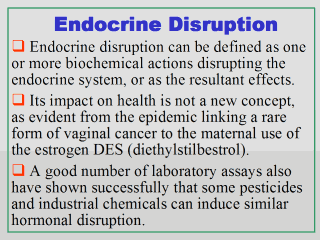| front |1 |2 |3 |4 |5 |6 |7 |8 |9 |10 |11 |12 |13 |14 |15 |16 |17 |18 |19 |20 |review |
 |
Endocrine
disruption can be broadly defined as one or more biochemical actions
disrupting the endocrine system in our body, or as the resultant effects. In
most cases where the biochemical action is not therapeutic, the resultant
effects can be detrimental and even fatal. Therefore, in most instances,
such a biochemical interference or disruption is toxicological in nature,
rather than pharmaceutical. To many health professionals, the concept that endocrine disruption can cause adverse health effects is not new. In 1970, for example, clinicians were able to link many women’s use of diethylstilbestrol (DES) to a rare form of vaginal cancer (clear cell carcinoma) found in their daughters from preteen to as old as in the 30s. DES is an estrogen first synthesized in 1938, and was commonly prescribed for prevention of miscarriages from 1940 until banned in the US in 1971. Some daughters of DES-treated women were further found to have an increased risk of reproductive and immunologic abnormalities; and some sons of the treated women were at an increased risk for non-cancerous epididymal cysts and abnormal spermatogenesis. In recent years, a good number of laboratory assays have also shown successfully that some pesticides and other industrial chemicals can induce the DES type of hormonal disruption directly or indirectly. Because these chemicals are often present as environmental pollutants, their persistence in the environment is thus of great concern from a public health perspective. The health concern over their persistence effects, which is the heart of this three-part lecture, can be further appreciated with some understanding of how the endocrine system works. It is for this reason that an overview of the endocrine system is presented in the next few slides. |